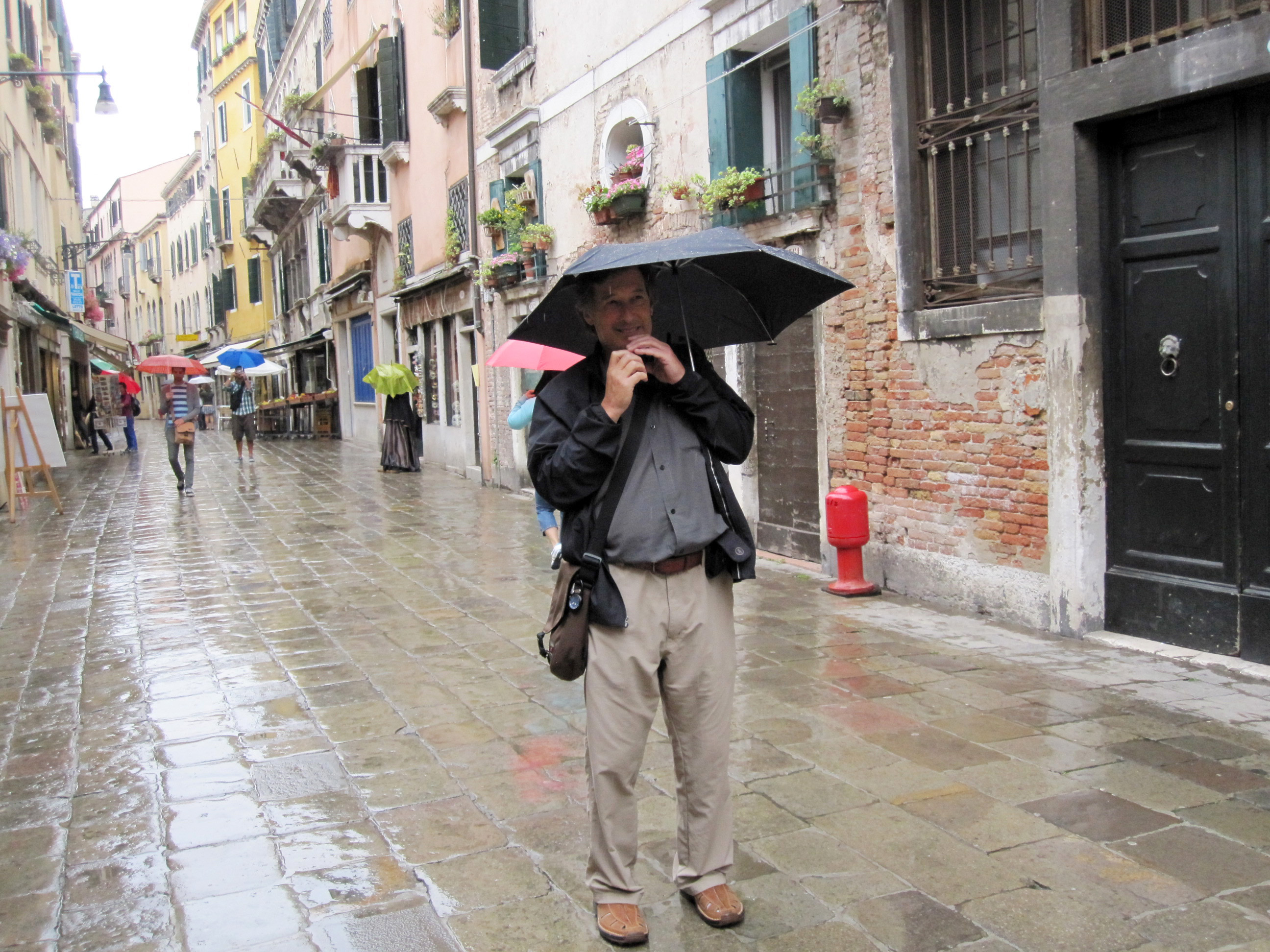 It was an early flight but it was really inexpensive. We arrived to the Venice airport at 7:30am but couldn’t check into the apartment until 2:15pm. We planned to leave just our bags at the train station, have a walkabout and pick them up later. Upon arriving to the terminal at the Aeroporto Marco Polo, we saw a ticket machine to buy bus tickets into Venice. They offered a €3 ticket to Piazzale Roma or a €3 ticket to the train station. Hmmm, we were told to leave our bags at the train station, but but the train station was in Piazzale Roma. Confusion…We chose the train station. Wrong choice. The train station was Mestre. We didn’t realize we were at the wrong station till after we checked out bags at the luggage deposit for €12. There we were, walking out of the train station only to find out there were no canals, no vaporetto (water bus). We were in a big industrial zone. Unfortunately the checked bag system doesn’t allow refunds, even though our bags were only there for 5 minutes. It’s a small price for a good education.
It was an early flight but it was really inexpensive. We arrived to the Venice airport at 7:30am but couldn’t check into the apartment until 2:15pm. We planned to leave just our bags at the train station, have a walkabout and pick them up later. Upon arriving to the terminal at the Aeroporto Marco Polo, we saw a ticket machine to buy bus tickets into Venice. They offered a €3 ticket to Piazzale Roma or a €3 ticket to the train station. Hmmm, we were told to leave our bags at the train station, but but the train station was in Piazzale Roma. Confusion…We chose the train station. Wrong choice. The train station was Mestre. We didn’t realize we were at the wrong station till after we checked out bags at the luggage deposit for €12. There we were, walking out of the train station only to find out there were no canals, no vaporetto (water bus). We were in a big industrial zone. Unfortunately the checked bag system doesn’t allow refunds, even though our bags were only there for 5 minutes. It’s a small price for a good education.
Two euros later we were on the train to the Santa Lucia train station and €12 euros later we checked our bags at the left baggage depot. €52 euros later we had a pair of 2 day vaporetto passes in hand and we were on our way into the city.
It was raining and we were tired , but within minutes we were intoxicated with the beauty and charm of this city. We stopped for a pizza involtini (pizza roll) near the Rialto bridge, we wandered through the old vegetable markets, we walked for hours and had no idea where we were going and yet you can always run into a vaporetto stop. Before we knew it, it was 2:30pm and we met our apartment greeter at the San Polo boat stop. We were shown to our apartment, got settled in and got back out into the streets as soon as possible. The apartment was OK for a three day visit. It was clean and comfortable, a new renovation in the San Polo sestiere, the smallest of the six sestiere (districts) in the city. San Polo might be the smallest but it also is home to The Rialto Bridge, the Scuola Grande di San Rocco (home of the best collection of Tintoretto paintings), a few of the oldest churches in the city and the Campo San Polo, the second largest square in Venice where nothing happens. San Polo is very relaxed and doesn’t get the tourist density of San Marco or the Dorsoduro. It’s actually nice and quiet. And it’s a short walk to the vaporetto dock.
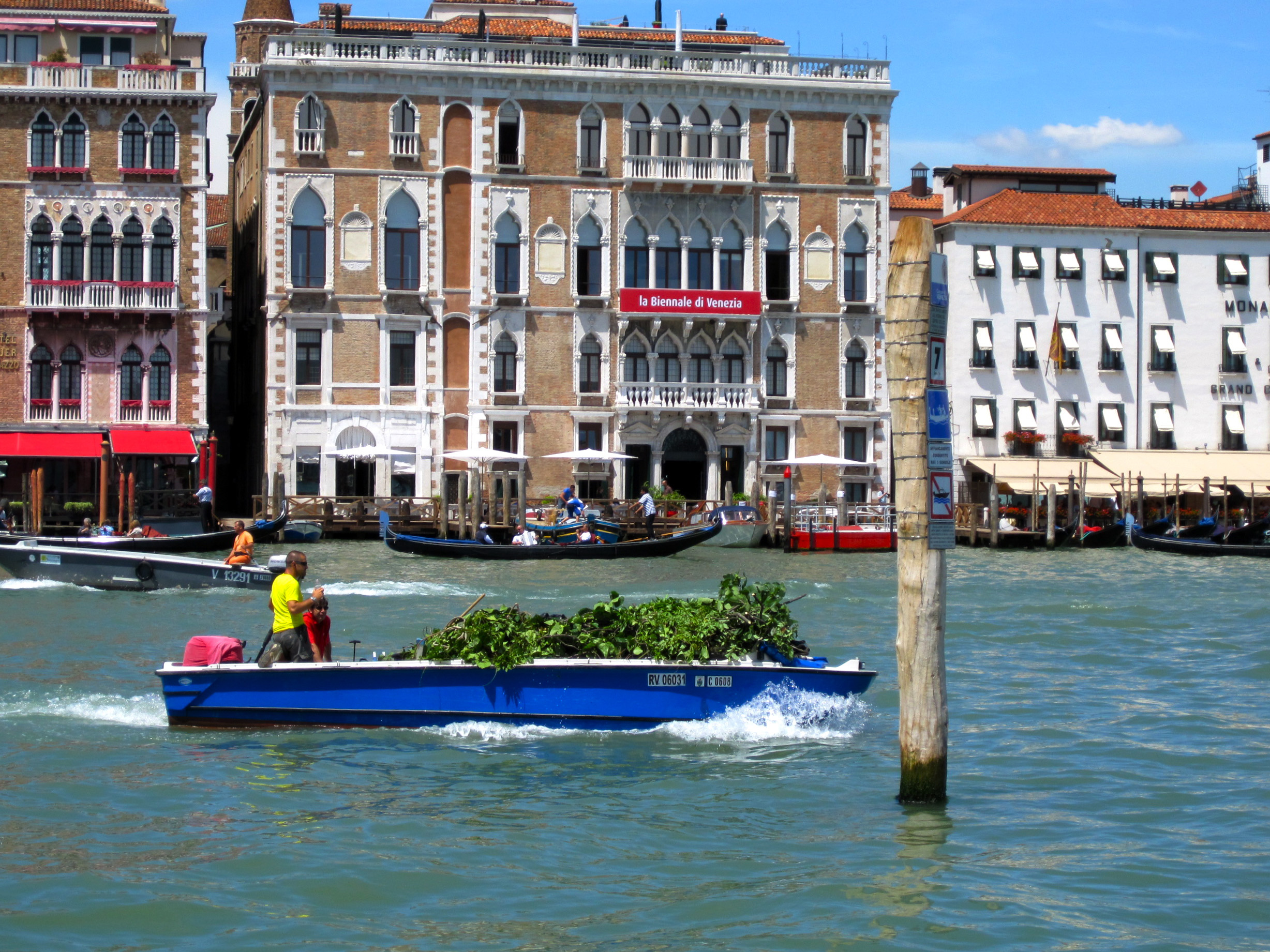 We spent a lot of time cruising up and down the Grand Canal from Piazzale Roma to the Lido; getting out for a brief walk to the Lido beach and getting back on Vaportetto and checking out some of the other stops. It’s a great way to see the city. The #1 boat stops at all the best places.
We spent a lot of time cruising up and down the Grand Canal from Piazzale Roma to the Lido; getting out for a brief walk to the Lido beach and getting back on Vaportetto and checking out some of the other stops. It’s a great way to see the city. The #1 boat stops at all the best places.
Our best ride that day was the sunset cruise. There is really nothing like watching the sun set along the grand Palazzi of the Grand Canal. A 3 day vaporetto pass costs €36. It might sound expensive but a single ticket is €6.50. Three trips on the vaporetto pays for the day and if you’re into getting around the city.the vaportetto is the way to go. By the way, the bus tickets between Piazzale Roma and the airport are also included. So are the boats out to the islands of Burano and Murano. Buy the pass, you won’t regret it. One more thing, if you try to get on the boat without paying or with an expired pass the fines are very expensive. You might hear from some people that they never bought a ticket and they were never caught. Don’t listen to them. Our passes were checked at least twice a day. If they catch you, you’ll pay..
The Scuola Grande di San Rocco, a 5 minute walk from our apartment, is filled with Tintoretto paintings. The school was established in 1478 next to the church of San Rocco, named after the Saint who rid the city of the plague in the 15th century. The building was mostly used for meetings of Supervisors of the sestiere and the church.
In 1560, Tintoretto won the commission to paint the interior. He was in his early 40’s and a very renown painter at the time. His father-in-law also happened to be the Grand Guardian of the Scuola di San Rocco. Tintoretto recreated both the old and new testaments on the walls and ceilings. It’s an amazing project. I have no idea of long it took him to finish but he was known as “Il Furioso” because he worked so fast. The halls are large and splendid but you’ll spend a lot of time looking up. Half of the work is on the ceilings.
 We jumped back on the vaporetto and had visit to Ca’ Rezzonico, a restored 18th century marble Venetian Palazzo on the Grand Canal. It’s a wonderful walk-back through time. The furniture is authentic but it might not have belonged to the 18th century owners. Giambattista Rezzonico bought the house from another patrician family in the 18th century. Venice was depleted of funds from the war with Turkey. Rezzonico was a wealthy merchant and Venice was broke. He not only bought the Palazzo, he bought his way into Venice nobility. The Palazzo was sold a few times in the 19th century. At one point it was owned by the English painter Robert (Pen) Browning, the son of the poets Robert and Elizabeth Barrett Browning. In 1935 it was purchased by the State, restored and turned into a great museum. The Tiepolo frescos throughout the Palazzo are all original. I’d love to have someone of his talent fresco’s the walls of my bedroom with Carnivale images like the ones at Ca’ Rezzonico.
We jumped back on the vaporetto and had visit to Ca’ Rezzonico, a restored 18th century marble Venetian Palazzo on the Grand Canal. It’s a wonderful walk-back through time. The furniture is authentic but it might not have belonged to the 18th century owners. Giambattista Rezzonico bought the house from another patrician family in the 18th century. Venice was depleted of funds from the war with Turkey. Rezzonico was a wealthy merchant and Venice was broke. He not only bought the Palazzo, he bought his way into Venice nobility. The Palazzo was sold a few times in the 19th century. At one point it was owned by the English painter Robert (Pen) Browning, the son of the poets Robert and Elizabeth Barrett Browning. In 1935 it was purchased by the State, restored and turned into a great museum. The Tiepolo frescos throughout the Palazzo are all original. I’d love to have someone of his talent fresco’s the walls of my bedroom with Carnivale images like the ones at Ca’ Rezzonico.
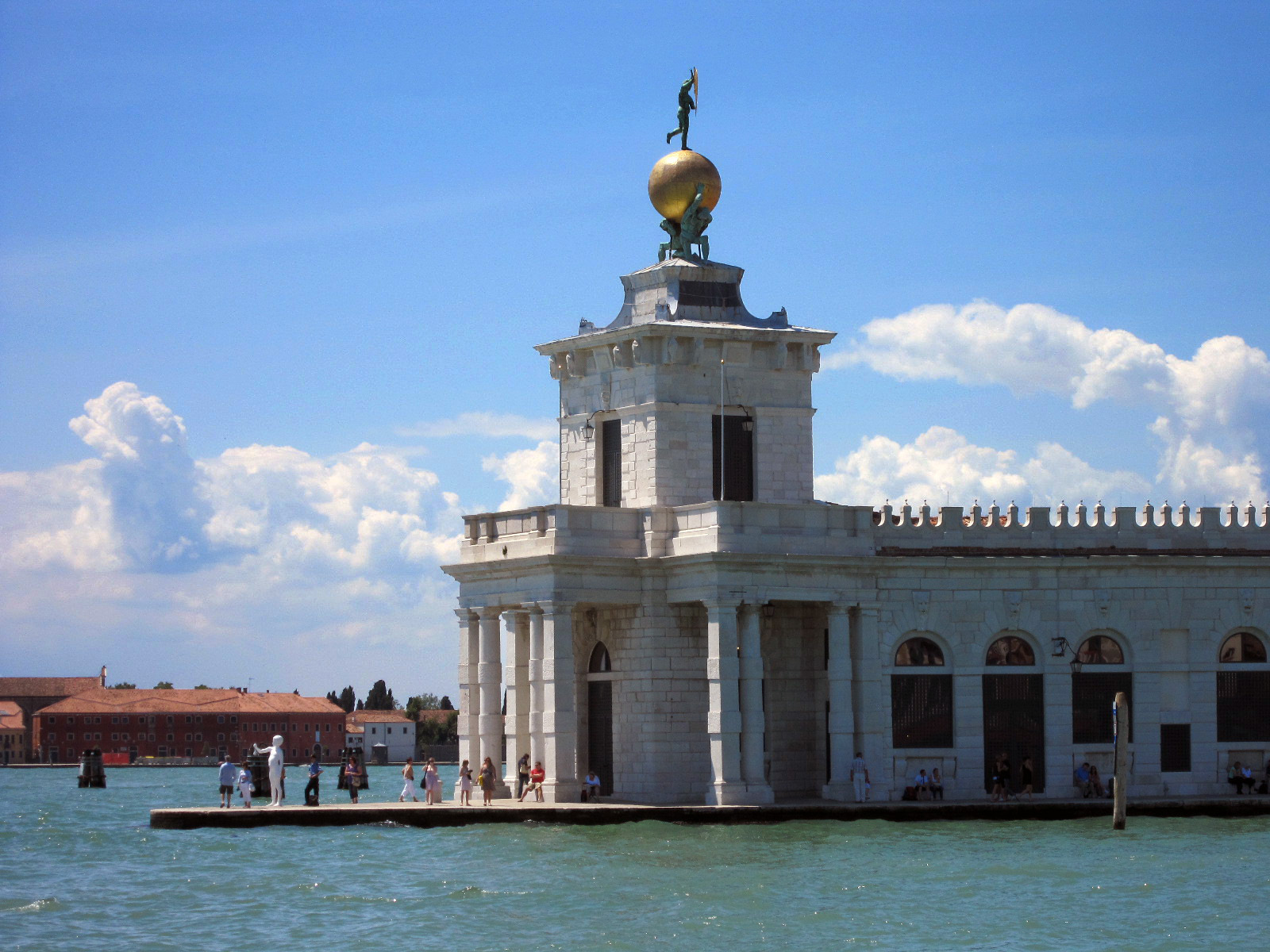 There is a brand new modern art museum at the renovated Punta della Dogana warehouse. It’s part of the private art collection of Francois Pinault the owner of the French company PPR. Among Pinault’s assets are, Converse shoes, Gucci, Samsonite luggage, Chateau Latour, the Vail ski resort and Christies auction house. Pinault is a big art collector. His art collection is one of the largest in the world. In 2006, he purchased the Palazzo Grassi on the Grand Canal in Venice, one of the city’s best museums. In 2009, after extensive renovation, he opened the Punta della Dogana for his larger, more modern pieces. It’s a beautiful building but like many other Museums in Venice, it’s closed on Tuesday.
There is a brand new modern art museum at the renovated Punta della Dogana warehouse. It’s part of the private art collection of Francois Pinault the owner of the French company PPR. Among Pinault’s assets are, Converse shoes, Gucci, Samsonite luggage, Chateau Latour, the Vail ski resort and Christies auction house. Pinault is a big art collector. His art collection is one of the largest in the world. In 2006, he purchased the Palazzo Grassi on the Grand Canal in Venice, one of the city’s best museums. In 2009, after extensive renovation, he opened the Punta della Dogana for his larger, more modern pieces. It’s a beautiful building but like many other Museums in Venice, it’s closed on Tuesday.
And so we walked the canals, got lost, jumped on and off the vaporetti, got lost, looked through the shop windows at glass, masks, clothing, art, jewelry, food, junk and then got lost again. We finally arrived into the Piazza San Marco and bought some tickets for the following day to the Doge’s Palace and a tour of the Clock tower. The tower closed for renovations in 1998 and finally reopened in 2006. It’s been under wraps for a long time.
Around 3pm we found ourselves in front of La Fenice Opera House. There was a big banner over the door that read in response to the economic cuts to the arts in Italy, today’s dress rehearsal of “The Turn of the Screw” is open to the public free of charge.
Let’s see, free entrance inside one of the most beautiful Opera Houses in Europe and free tickets to see the opera? We’ll take two please.
We settled into our seats on the top tier and caught the second act of the Opera “The Turn of the Screw” by Benjamin Britten, based on the ghost story by Henry James. The Opera, commissioned by the Venice Biennale, made it’s first appearance here at La Fenice in 1954. It’s in English but somehow through the operatic delivery the words got lost. We were actually grateful for the Italian translations above the stage proscenium.
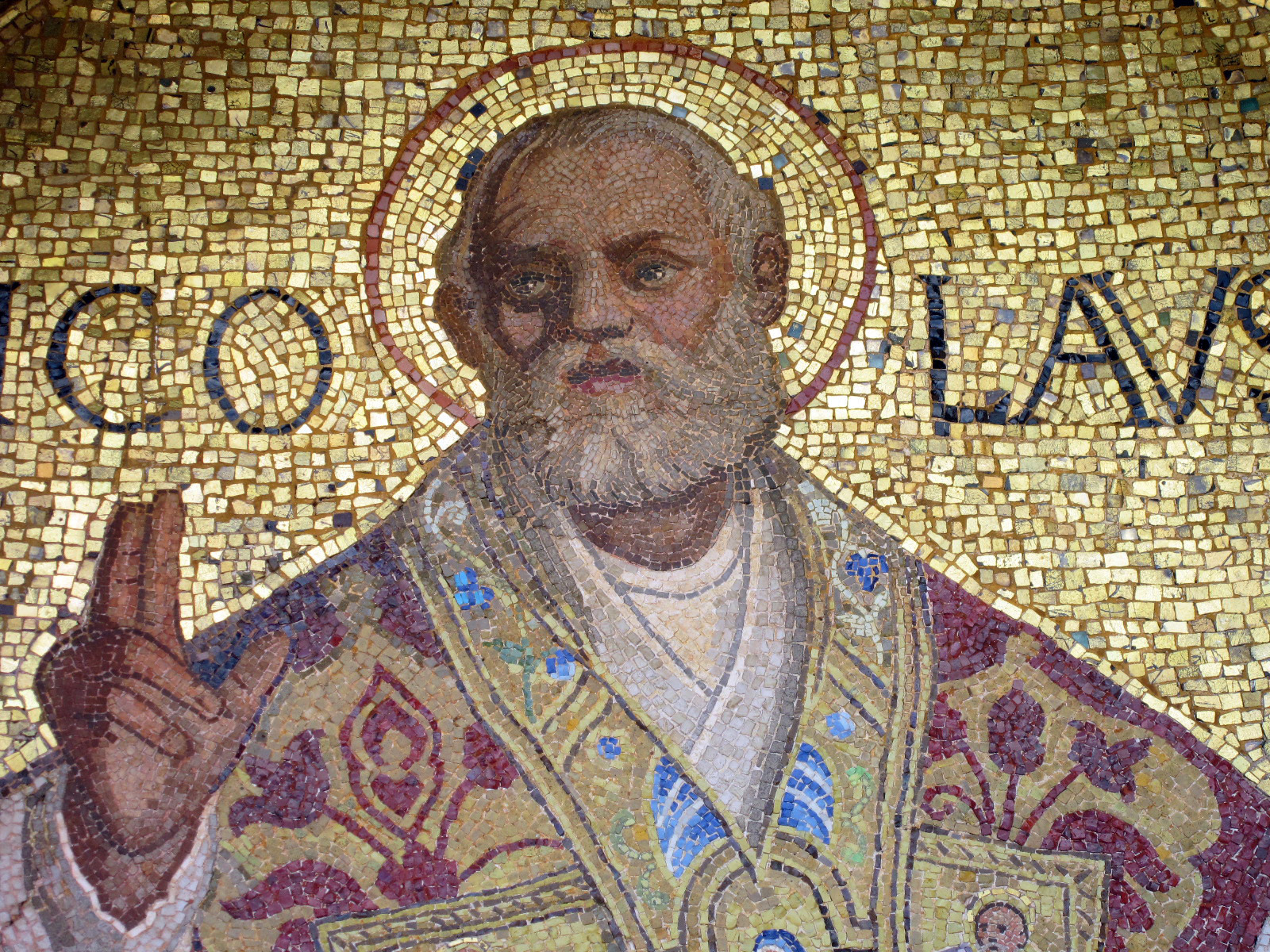 On our last day here, we hopped on the vaporetto to San Marco. First stop, the Basilica of San Marco; the greatest Byzantine church in all of Italy, possibly in the world. I can’t decide if I’m more amazed at 86,111 square feet of mosaics in the church or the fact that this massive structure has been sitting on a bunch of pilings on a sandy foundation since 1094. The mosaics by the way, tell the story of the salvation brought by Jesus and are read from east to west. It is so clever. The sun rises in the east. You enter the Basilica in the morning and read the mosaics till sundown, that is, of course, if the sun is out. There is no reading of the salvation brought by Jesus on cloudy or rainy days.
On our last day here, we hopped on the vaporetto to San Marco. First stop, the Basilica of San Marco; the greatest Byzantine church in all of Italy, possibly in the world. I can’t decide if I’m more amazed at 86,111 square feet of mosaics in the church or the fact that this massive structure has been sitting on a bunch of pilings on a sandy foundation since 1094. The mosaics by the way, tell the story of the salvation brought by Jesus and are read from east to west. It is so clever. The sun rises in the east. You enter the Basilica in the morning and read the mosaics till sundown, that is, of course, if the sun is out. There is no reading of the salvation brought by Jesus on cloudy or rainy days.
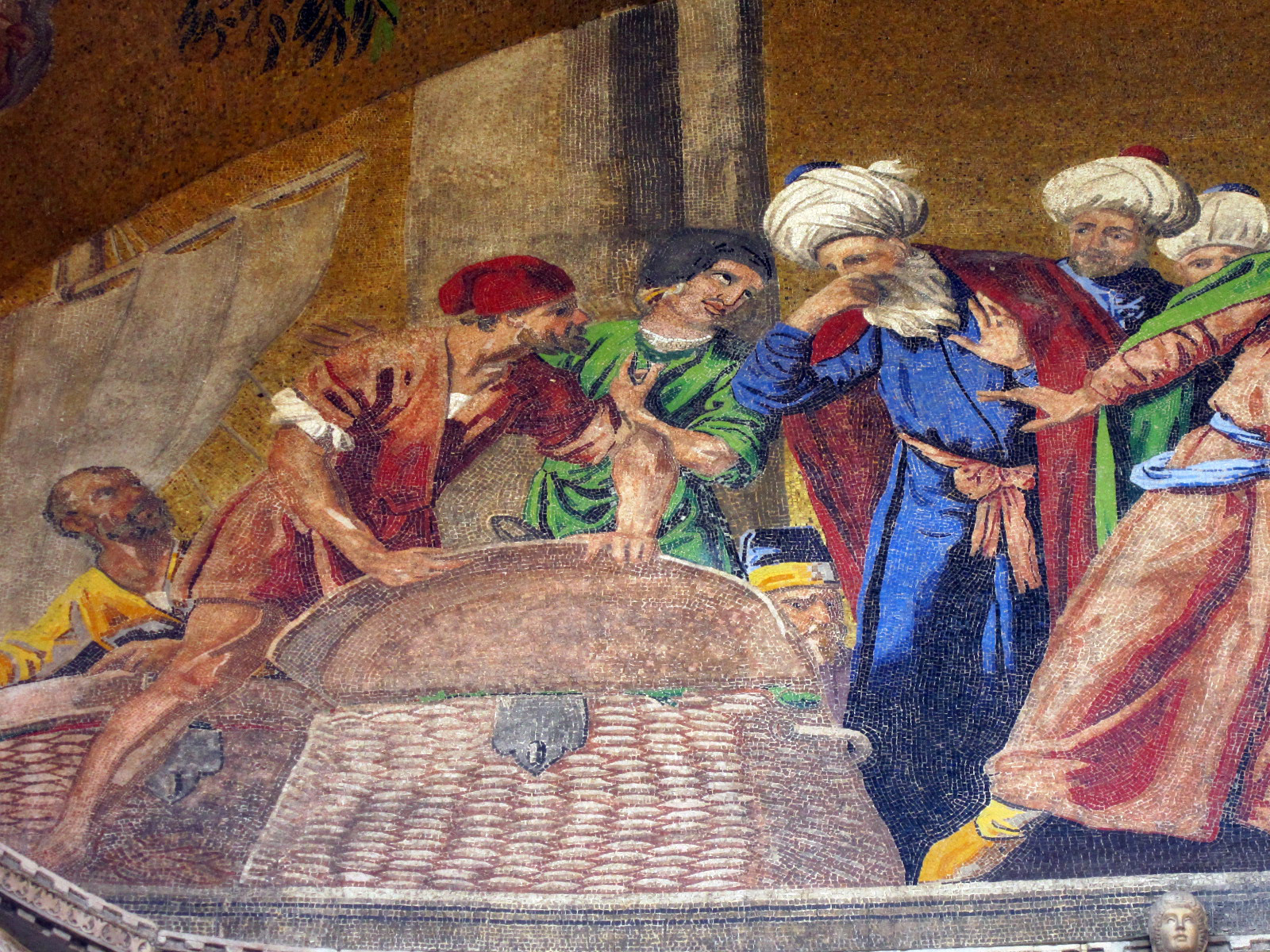 The church was consecrated after two Venetians (supposedly) stole and smuggled the corpse of Saint Mark the Evangelist out of Alexandria, Egypt. They hid him in a basket of rotting pork to get him by the Muslim guards checking the cargo before the Venetians left the port. When the Muslims saw (and smelled) the soiled pork, they grabbed their noses, and looked the other way. As the story continues, the ship veered off course and was about to crash on a reef when the Saint mark appear to the crew and guided them safely back to Venice. That was all they needed to build the grand Basilica.
The church was consecrated after two Venetians (supposedly) stole and smuggled the corpse of Saint Mark the Evangelist out of Alexandria, Egypt. They hid him in a basket of rotting pork to get him by the Muslim guards checking the cargo before the Venetians left the port. When the Muslims saw (and smelled) the soiled pork, they grabbed their noses, and looked the other way. As the story continues, the ship veered off course and was about to crash on a reef when the Saint mark appear to the crew and guided them safely back to Venice. That was all they needed to build the grand Basilica.
 Aside from the mosaics and the great views from the loggia, we had to see the four horses of the Triumphal Quadriga, now housed in the San Marco museum on the top floor of the Basilica. These bronze stallions were fabricated in the 2nd century (although some believe they came from the 4th century BC Greece). They once sat in the Hippadrome of Constantinople before they were taken in the 1204 Venetian sack of the city under Doge Enrico Dandolo.
Aside from the mosaics and the great views from the loggia, we had to see the four horses of the Triumphal Quadriga, now housed in the San Marco museum on the top floor of the Basilica. These bronze stallions were fabricated in the 2nd century (although some believe they came from the 4th century BC Greece). They once sat in the Hippadrome of Constantinople before they were taken in the 1204 Venetian sack of the city under Doge Enrico Dandolo.
The four horses were positioned above the entrance to St Marks until 1797 when Napoleon took them to Paris where they were used for the design of the Quadriga on top of the Arch du Triomphe. The horses came back to St Marks in 1815 and returned to their position on the exterior of the Basilica till the 1980’s. POllution was destroying them so copies were made for the exterior and the originals were put inside.
After fighting the crowds of St Mark’s, we walked next door to the Doge’s Palace for a couple of hours. We’ve been here a few times so it was mostly a refresher tour of the map room (copies of maps originally made by Marco Polo) and Sala del Maggior Consiglio (the Hall of the Great Council). Three sides of the enormous hall is decorated with large paintings glorifying the victories (and booty) of the 4th crusade in 1204 when Venice sacked and plundered Constantinople. Above the crusade paintings are small portraits of the first 76 Doges; well, actually 75 Doges. The portrait of the 55th Doge, Marino Faliero , has a black veil over it. Falier was convicted of trying to stage a coup to give himself absolute power. He admitted the guilt and was beheaded, mutilated and condemned to Damnatio Memoriae , where all traces of him would be expunged from memory. If they wanted to remove all traces of him in the history of Venice, they should have just ignored him. Now, thanks to the black veil and the story, he’s one of the most famous of all the Doge.
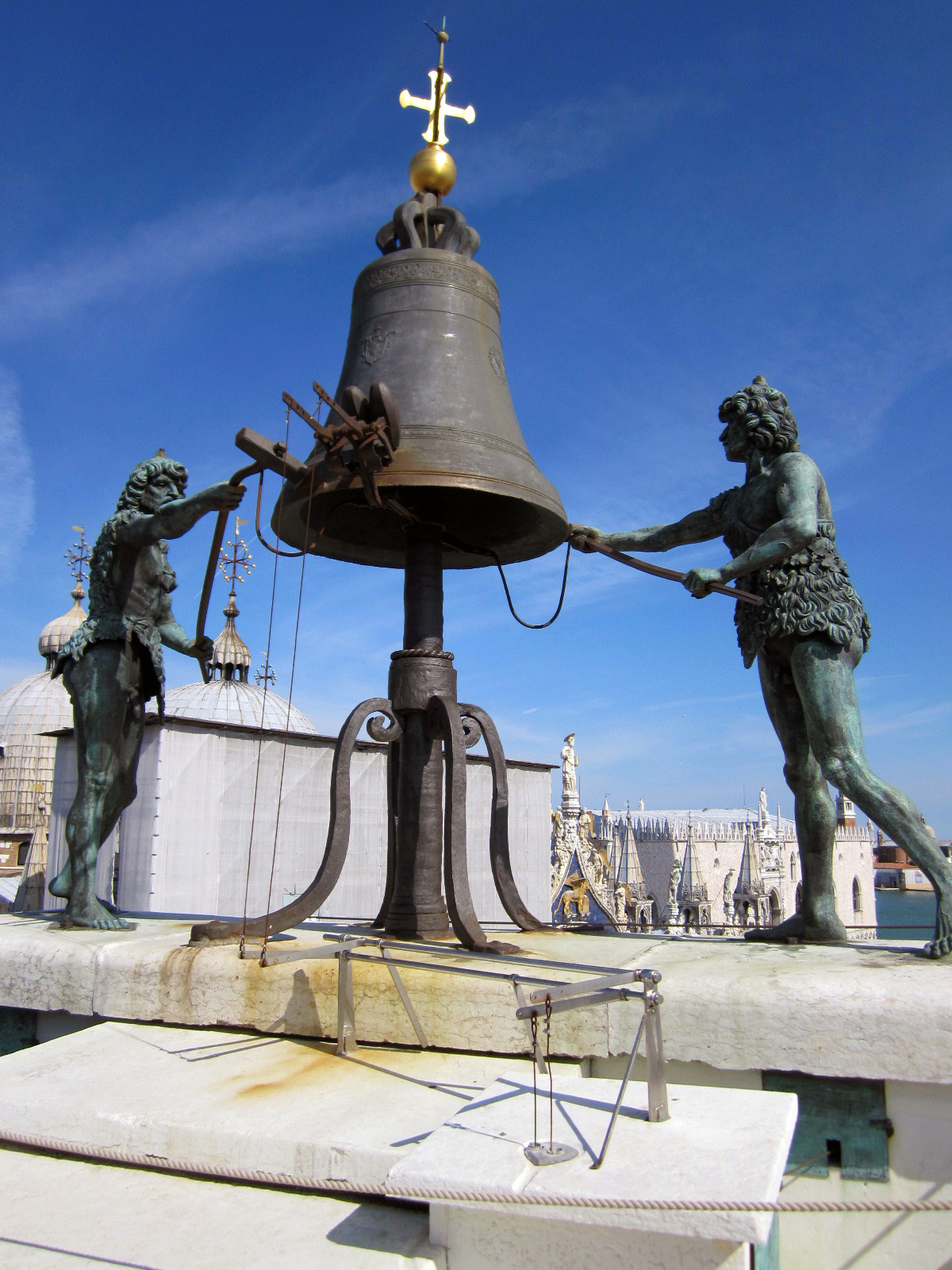 We had just enough time to catch our 4pm tour of the St Mark’s Clock Tower. Even though the tour was in Italian we were fine in keeping up. Our Italian teachers would have been really proud of us. The guide explained that this is the 2nd most famous clock tower in the world. The 1st is Big Ben in London and the 3rd is the Astronomical clock of Prague.
We had just enough time to catch our 4pm tour of the St Mark’s Clock Tower. Even though the tour was in Italian we were fine in keeping up. Our Italian teachers would have been really proud of us. The guide explained that this is the 2nd most famous clock tower in the world. The 1st is Big Ben in London and the 3rd is the Astronomical clock of Prague.
At the top of the clock tower are two bronze bell ringers, fabricated in 1494. Even though they look like peasants in sheepskins, they are referred to as the Moors, probably in disdain for the eternal enemy of the city. One of the figures is old, representing the past and the other is young, representing the future.
The old Moor hits the bell 2 minutes before the hour, the young Moor strikes the bell at 2 minutes past the hour. This way, they figure they’ll get it somewhere near the right time. Time doesn’t need to be that precise here.
One side of the clock, facing towards the Grand Canal, has an astronomical clock with the signs of the zodiac to help the sailors. The other side, facing through the archway into the merchant shops of the Mercerie is basically a regular clock that tells the shop keepers when to close up, although these days, as long as there are tourists, the shops filled with Venetian glass and Carnival masks will stay open.
Venetian glass goes back to the 13th century. The origins are mixed with Venetian and Byzantine artisans around the same time as the 1204 sack of Constantinople. These days most of the glass comes from the small island of Murano where the same families have been crafting the art for centuries. The colors are bold and bright. The pieces range from large chandeliers to vases, platters, and down to small glass cherries.
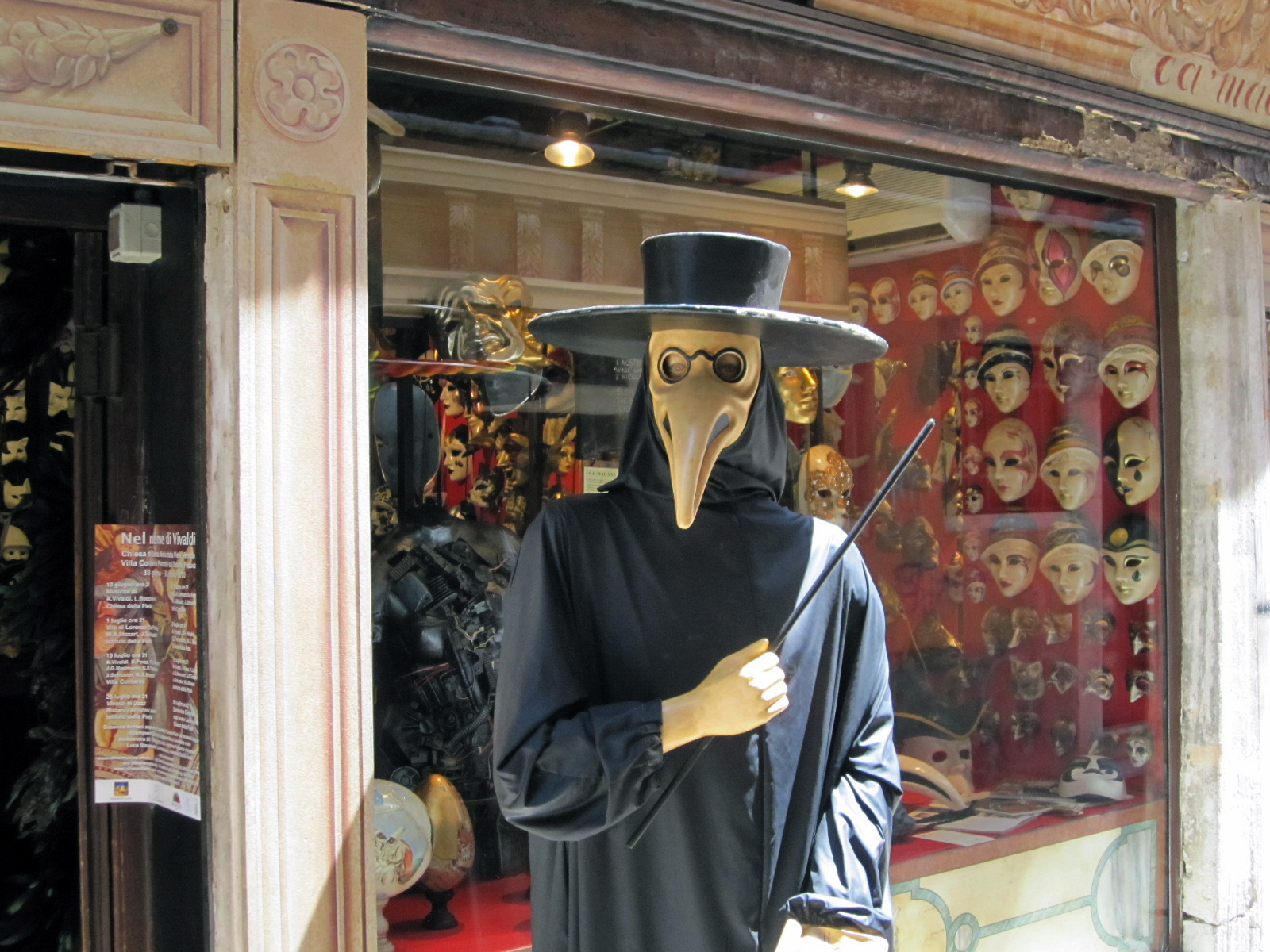 The Carnivale masks (from the latin Carne Vale, without meat) have a long tradition in Venice. From 1487 – 1565 Carnivale festivities were coordinated by the Compagnie di Calze, 23 groups all distinguished by the patterns of their stockings. They arranged Balls and private Parties for all classes of Venetian society.
The Carnivale masks (from the latin Carne Vale, without meat) have a long tradition in Venice. From 1487 – 1565 Carnivale festivities were coordinated by the Compagnie di Calze, 23 groups all distinguished by the patterns of their stockings. They arranged Balls and private Parties for all classes of Venetian society.
When Venice was controlled by Austria in 1797, masks were outlawed. It was hard enough for the authorities to track down criminals without having them committing crimes wearing masks. In the 1930’s Mussolini banned Carnivale altogether.
In 1979, local artisans brought back the old leather mask traditions and these days, Carnivale has become one of the most popular times to visit Venice. Over 120,000 people come into the city for Fat Tuesday alone. Mask stores rule in Venice.
Most of the 17th century masks come from characters derived from the Commedie dell’Arte, a social satire stemming from the ancient Romans. It’s an improvised play using current events, local gossip around a story of love and deceit.
The main characters are the lovers trying to marry but first they must deal with the incompetent parents Il Dottore and Pantalone, the cunning servants Arlechino and Columbina, the braggarts Il Capitan and Scaramuccia, the clowns Pedrolino and Pagliacci and a whole bunch of others characters from the city.
The other traditional mask is the long aquiline face reminiscent of the mask used by 15th and 16th century Doctors while treating patents with the plague, thinking the chamber of the long masks, filled with an antiseptic would filter the air and prevent them from catching the disease.
You must be logged in to post a comment.